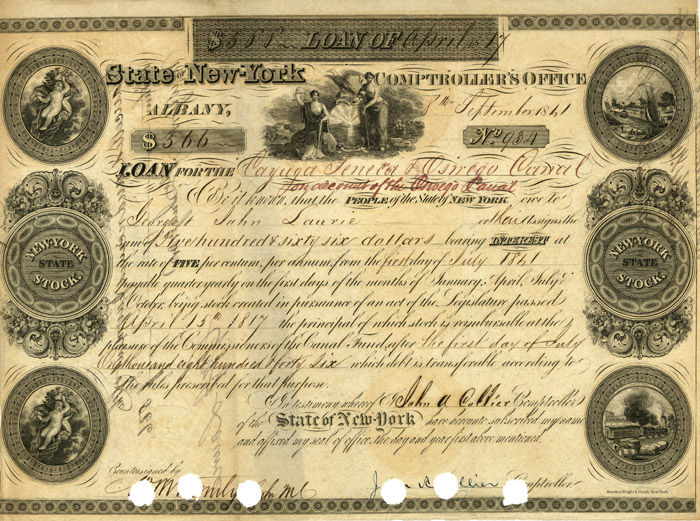Cayuga Seneca and Oswego Canal Bond - 1846 dated State of New York Comptrollers Office
Inv# GS5582 Bond
State of New York Comptrollers Office 5 Beautiful Vignettes. The New York State Canal System (formerly known as the New York State Barge Canal) is a successor to the Erie Canal and other canals within New York. The 525-mile (845 km) system is composed of the Erie Canal, the Oswego Canal, the Cayuga–Seneca Canal, and the Champlain Canal. In 2014 the entire system was listed as a national historic district on the National Register of Historic Places, and in 2016 it was designated a National Historic Landmark.
The Erie Canal connects the Hudson River to Lake Erie; the Cayuga–Seneca Canal connects Seneca Lake and Cayuga Lake to the Erie Canal; the Oswego Canal connects the Erie Canal to Lake Ontario; and the Champlain Canal connects the Hudson River to Lake Champlain.
In 1903 New York State legislature authorized construction of the "New York State Barge Canal" as the "improvement of the Erie, the Oswego, the Champlain and the Cayuga and Seneca Canals". In 1905, construction of the Barge Canal began; it was completed in 1918, at a cost of $96.7 million. It opened to through traffic May 15, 1918. The Barge Canal's new route took advantage of rivers (such as the Mohawk River, Oswego River, Seneca River, Genesee River and Clyde River) that the original Erie Canal builders had avoided, thus bypassing some major cities formerly on the route, such as Syracuse and Rochester. However, particularly in western New York State, the canal system uses the same (enlarged) channel as the original Erie Canal. In 1924 the Barge Canal built the Gowanus Bay Terminal in Brooklyn to handle canal cargo. Read more at https://en.wikipedia.org/wiki/New_York_State_Canal_System
A bond is a document of title for a loan. Bonds are issued, not only by businesses, but also by national, state or city governments, or other public bodies, or sometimes by individuals. Bonds are a loan to the company or other body. They are normally repayable within a stated period of time. Bonds earn interest at a fixed rate, which must usually be paid by the undertaking regardless of its financial results. A bondholder is a creditor of the undertaking.










Ebay ID: labarre_galleries